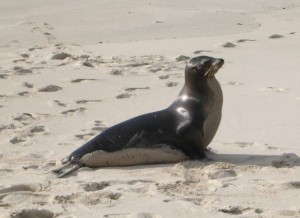
Photo credit: Marc Figueras
I have finally made it to the “C” section of the Encyclopedia of Marine Mammals! Wow, blogging my way through the encyclopedia is going to take awhile. And so the C’s begin with the California, Galapagos and Japanese sea lions. My impression is that they were all grouped together in the C’s because California sea lions have been extensively studied, all the sea lions are closely related and Japanese sea lions are extinct, so there’s not too much to say about them.
Since I have already written about California sea lions, I’m going to focus more on Galapagos and Japanese sea lions in this post. But alas, not as much is known about Galapagos sea lions. The encyclopedia article written by Carolyn Heath and William Perrin describes Galapagos sea lions as “smaller than California sea lions and appear to be much less sexually dimorphic.” Meaning the Galapagos males and females are closer in size than the California sea lions.
Female Galapagos sea lions weigh around 175 pounds while California sea lions average closer to 240 pounds. Apparently, weight estimates for Galapagos males are not available. Both females and males spend their days hunting for sardines, their favorite meal. But when sardines are scarce during El Nino years, then Galapagos sea lions also eat green eyes (a type of small fish) and lantern fish.
The life-cycle of Galapagos sea lions is similar to California sea lions, males establish territories within rookeries located along the beaches of the most isolated Galapagos islands. Here mating takes place, but mostly along the water’s edge to prevent overheating from the sun. Young sea lions are playful and spend time “chasing and mock fighting with each other.”
What I found most interesting is that Galapagos sea lions have a much tougher time dealing with El Nino than their California counterparts to the north. Apparently, the isolation of the Galapagos Islands doesn’t give them the option to swim further north to more productive waters as fish disappear from warmer coastal areas as many California sea lions do. According to the Encyclopedia of Marine Mammals: “Following the 1997-1998 El Nino, which was accompanied by up to 90% pup mortality and 45% overall mortality, the population was estimated at only about 14,000 individuals.”
Only 14,000 Galapagos sea lions compared to close to 250,000 California sea lions and zero Japanese sea lions. And what happened to the Japanese sea lions you ask? Well, they were pretty much hunted to extinction from the late 1800s to the mid 1900s. There were possibly 50 to 60 left by the 1950s, but they are now listed as extinct. Another animal bites the dust thanks to human exploitation and our ongoing abuse of natural resources.
In an effort to end on a positive note, thankfully the Galapagos sea lions have been spared hunting thanks to living in such a remote area. Let’s just hope they can figure out how to make it through reoccurring El Nino weather patterns. Maybe it’s time to start eating jellyfish?
Leave a Reply